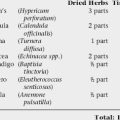BLACK COHOSH
Botanical name: Actaea racemosa syn. Cimicifuga racemosa
Synonyms: Black bugbane; Black snakeroot
PRINCIPAL USES
TRADITIONAL AND HISTORICAL USES
with tenderness, false pains, irregular pains, rheumatism of the uterus, dysmenorrhea.” They also recognized its value as a superb sedative. It was considered to have particular affinities for the uterus, heart, and circulatory system, supposedly improving (cardiac) contractile force; however, this indication has not been widely studied nor borne out by limited scientific evaluation of the plant. It was considered a reliable herb to aid in birth and relieve pain afterward, given in small doses before, during, and after labor. Its effects for the treatment of all manner of musculoskeletal and neuralgic pains were widely reputed. Listed in the USP from 1820 until 1920, it was and continues to be one of the most popular herbal medicines sold in Western nations.
CLINICAL INDICATIONS
Black cohosh is the most widely sold and used herb in western nations for the treatment of perimenopausal neurovegetative complaints. It is commonly used for such by herbal practitioners and research has largely centered on its use for these purposes. Herbal practitioners also use black cohosh as a reliable anti-inflammatory, antispasmodic, and analgesic for all manner of neuromuscular complaints, for premenstrual headache, as well as for treating spasmodic or paroxysmal coughs. Plant Profile Black Cohosh Table 2 lists the uses of this herb by contemporary herbalists and naturopathic physicians.
TABLE 2 Common Uses of Black Cohosh in Modern Herbal Practice
| Dysmenorrhea |
| Ovarian pain |
| Neurovegetative menopausal symptoms: hot flashes, reduction of sweating, headache, heart palpitations, anxiety, nervousness, insomnia, irritability, depression (for the latter in combination with Hypericum perforatum (St. John’s wort), and possibly vaginal dryness and atrophy |
| Musculoskeletal pain; i.e., myalgia, sciatica, arthritis, neuralgia |
| Premenstrual migraine |
| Cough |
| Osteoporosis |
| Possible additional indications include |
| Uterine contractions in threatened miscarriage (see Use in Pregnancy and Lactation) |
TABLE 1 Black Cohosh for Gynecologic and Obstetric Problems: Eclectic Medical Uses
| Treat uterine and ovarian neuralgia |
| Antispasmodic for generalized and uterine “rheumatic” pains |
| Uterine irritability |
| Irritated and congested pelvic conditions |
| Amenorrhea |
| Dysmenorrhea |
| Hysteria |
| Relieves irregular pains and uterine contractions |
| Partus accelerator |
| Partus preparator |
| Postpartum hemorrhage |
| Relaxes the soft parts of the parturient canal and facilitates delivery |
| Relieves insomnia, relieves reflex irritability thus quieting morning sickness |
| Relieves spasmodic pains of early labor and due to its relaxing effects, reduces laceration at birth |
| Maintains uterine contraction after birth |
MECHANISMS OF ACTION
There is considerable interest in understanding the mechanisms of black cohosh. Nonetheless, in spite of its popularity, its mechanisms have not been elucidated. Studies on estrogenic activity have been contradictory. In spite of initial studies suggesting estrogenic effects, many recent studies demonstrate lack of systemic estrogenic effects and even antiestrogenic effects, with no changes in LH, FSH, prolactin, and SHBG, and no changes in endometrial or vaginal proliferation. SERM activity has also been postulated, however, some studies also demonstrate lack of binding to estrogen receptors. Recent in vitro and animal research suggests possible serotinergic effects, and receptor binding assays suggest a possible dopaminergic mechanism of action.
RATINGS
DOSAGE
Dried Root and Rhizome
Dose recommendations vary from as low as 40 to 200 mg daily to 1 to 3 g daily
SAFETY INFORMATION: HERB–DRUG INTERACTIONS, TOXICITY, AND CONTRAINDICATIONS
There are no expected herb–drug interactions, and even in combination with HRT, minimal side effects have been observed. No mutagenicity (Ames test) has been found and the herb has a very low toxicity risk based on animal toxicity studies. One case of nocturnal seizures was reported in a 45-year-old woman taking a combination of black cohosh, chaste tree, and evening primrose oil for menstrual irregularity. Her sister had also been taking this combination for duration of 1 to 2 years with no reported side effects. The woman’s seizures abated upon discontinuation of the herb, no other pathology was identified, and the seizures were not directly attributed to the herbs in combination or singly. The limited number of other adverse events that have reported (a thorough review of which is provided by Low Dog et al.) suggest that these may be owing to the use of the herb in combination with other herbal products or dietary supplements, or other ingredients in such combinations.
USE AND SAFETY IN PREGNANCY AND LACTATION
Contraindication of black cohosh during pregnancy appears to be based largely on historical records of this herb’s ability to affect uterine activity, with reports of its use both as a uterine stimulant (emmenagogue) and uterine relaxant by the Eclectic physicians. Numerous published Eclectics (Cook, Ellingwood, Felter, Howe, King, and others) regularly used black cohosh during pregnancy for the treatment of threatened miscarriage and premature labor, and for relaxation of a rigid os uteri during labor, suggesting its action as a uterine antispasmodic. Although this was not necessarily the first choice of treatment (Viburnum prunifolium being specifically indicated for threatened miscarriage), it was clearly used often and with comfort during pregnancy. In a seeming contradiction, however, it was also used as a partus preparator, an herb used in the last weeks of pregnancy to prepare the uterus for labor, as well as an herb to stimulate labor and effect an expedient delivery. It was considered a gentle and safe alternative to ergot at the time and still used in the form of ergonovine. Black cohosh was considered specifically able to effect regular and effective uterine contractions while eliminating irregular or nonproductive pain in labor. It was also used for postpartum uterine pain and the treatment of uterine subinvolution.








